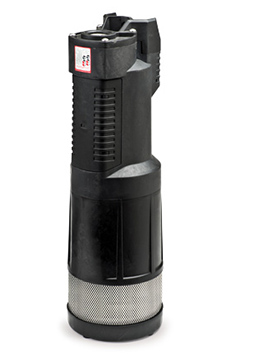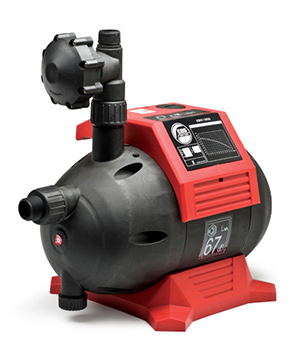100 Level 101- Chapter 2
Submersible vs. External Pumps

Submersible pump
Submersible pumps go directly into the water, which gives them certain advantages. First, they have flooded suction, where the inlet of the volute is below water level. There’s usually no need for inlet plumbing because the water flows right into the volute. Small leaks below the water line don’t really matter much, and the impeller design can be relatively simple and open, no need for close tolerances. These pumps can be designed to pass solids right through the volute, although the looser tolerances come at the cost of less electrical efficiency. Submersibles are also relatively hidden by definition; the water they sit not only hides them, it can muffle the sound of the pump as well. Submersibles have become the first choice for contractors and homeowners alike precisely because they are simpler to plumb, quiet running and out of sight.

External Pump
External pumps by definition live outside the pond, so they need inlet plumbing to get water up and into the volute. Because they have to draw the water up against the force of gravity, they have to be specially designed to self-prime,using only the water in the volute or a special self-priming basket to get the water flowing. They aren’t very good at drawing water high above pond water level, so they should be mounted as close and low as possible to the pond. Extra care should be taken with their inlet plumbing. A tiny leak in the inlet line won’t necessarily leak water, because while the pump is running the water is flowing strongly into the pump, but even a tiny leak will allow air to get in to the volute, and they will lose their prime and have to be restarted after the leak is corrected. On the other hand, their extremely well designed impellers and volutes confer remarkable efficiencies, important when moving very large volumes of water 24/7, as in larger Koi ponds, where they are strongly preferred. The fact that the koi pond owner doesn’t need to pull a pump out of the water for maintenance and service adds to their popularity with Koi kichi, as devoted fans of the Japanese colored carp are called.

Submersible pump
Submersible pumps go directly into the water, which gives them certain advantages. First, they have flooded suction, where the inlet of the volute is below water level. There’s usually no need for inlet plumbing because the water flows right into the volute. Small leaks below the water line don’t really matter much, and the impeller design can be relatively simple and open, no need for close tolerances. These pumps can be designed to pass solids right through the volute, although the looser tolerances come at the cost of less electrical efficiency. Submersibles are also relatively hidden by definition; the water they sit not only hides them, it can muffle the sound of the pump as well. Submersibles have become the first choice for contractors and homeowners alike precisely because they are simpler to plumb, quiet running and out of sight.

External Pump
External pumps by definition live outside the pond, so they need inlet plumbing to get water up and into the volute. Because they have to draw the water up against the force of gravity, they have to be specially designed to self-prime,using only the water in the volute or a special self-priming basket to get the water flowing. They aren’t very good at drawing water high above pond water level, so they should be mounted as close and low as possible to the pond. Extra care should be taken with their inlet plumbing. A tiny leak in the inlet line won’t necessarily leak water, because while the pump is running the water is flowing strongly into the pump, but even a tiny leak will allow air to get in to the volute, and they will lose their prime and have to be restarted after the leak is corrected. On the other hand, their extremely well designed impellers and volutes confer remarkable efficiencies, important when moving very large volumes of water 24/7, as in larger Koi ponds, where they are strongly preferred. The fact that the koi pond owner doesn’t need to pull a pump out of the water for maintenance and service adds to their popularity with Koi kichi, as devoted fans of the Japanese colored carp are called.




